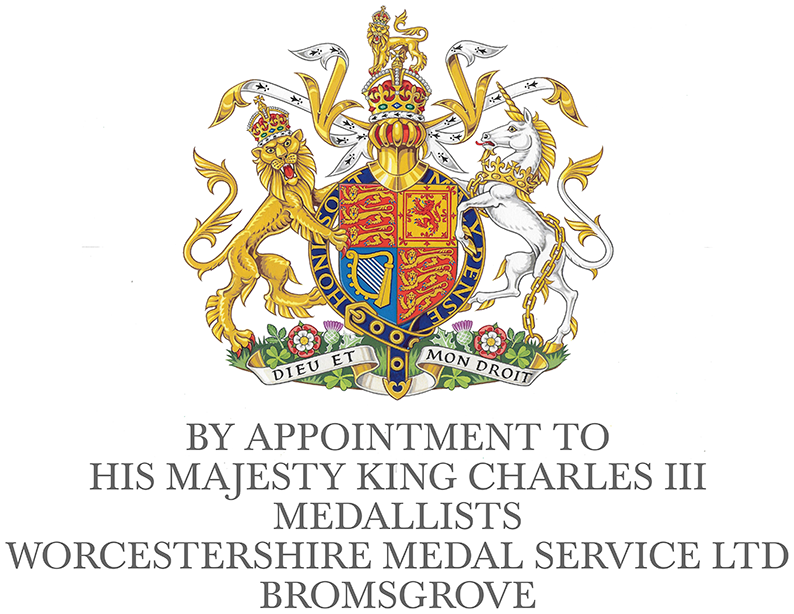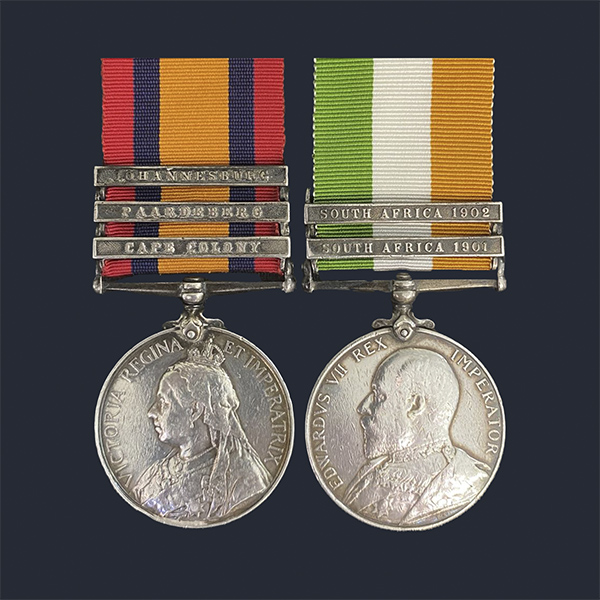George Cranstone
Corporal, 2nd Battalion, Hampshire Regiment – Anglo Boer War
- Queen's South Africa 1899-1902, 3 clasps Johannesburg, Paardeberg, Cape Colony (4494 LCPL G.CRANSTONE. 2ND HAMPSHIRE.REGT.)
- Kings South Africa 1901-1902, 2 clasps South Africa 1901, South Africa 1902 (4494 CORPL G.CRANSTONE. HAMPSHIRE REGT.)
George Cranstone was born in Alton, Hampshire on 1 June 1876 to William Cranstone, a General Labourer, and his wife Ellen (born Wright). Our first encounter with a young George comes courtesy of the 1881 England census where, at the age of 4, he was at home in Mount Pleasant, Alton along with his parents and siblings Henry (12), Rosina (6) and Louisa (2).
Ten years later, in 1891, the family had moved to Rack Close in Alton and, as was typical of working class Victorian families, the ranks of children had swelled. Brother Henry had moved on but Rosina (16) was still at home and contributing to the family coffers as a Rag Sorter. George was now 14 and, surprisingly, not yet put to work. Younger siblings over whom he could keep a watchful eye were Louisa (12), Caroline (9), Ellen (6) and Gathorne (4).
As the Victorian era wound to a close at the end of the 19th century, employment choices facing young working-class men were limited. They could (and many did) follow in the footsteps of their fathers’ or ply similar trades or they could opt for the “Queen’s Shilling” and join the army. George decided on the latter. Britain and her Empire were at their zenith when, at the age of 18 years and 5 months, he walked into the recruiting office at Alresford on 13 August 1894 expressing a desire to enlist with the Hampshire Regiment.
A Labourer by occupation, but having no desire to continue in that vein, he was a diminutive 5 feet 4 inches, weighed 120lbs. and had a fresh complexion, grey eyes and brown hair. A member of the Church of England, he sported a number of tattoos – these marks about his person being important should someone be required to identify his body. An impressive anchor, heart and head were festooned on his left forearm whilst, almost in competition with its fellow limb, the right forearm had a dancing girl, head and horseshoe emblazoned on it.
Having been found Fit by the army Doctor at nearby Winchester, Cranstone was assigned no. 4494 and the rank of Private – thereby commencing 12 Years Short Service – 7 years with the Colours and 5 years with the Reserve. Initially posted to the Depot, he was posted to the 2nd Battalion on 28 November 1894. After 5 years and 144 days at Home, he, and his battalion finally embarked for distant shores, sailing on the Assaye on about 4th January 1900, and arrived at the Cape about the 23rd.
The Anglo Boer War was in full swing by the time he arrived at the front. Commencing on 11 October 1899, the Boers had, initially, caught the small Imperial Garrison unprepared and on the hop and it wasn’t until the start of 1900 that things began to improve.
After arriving at the Cape, the 2nd Hampshire moved by train to the front where F Company, under Major Norman Welch, was detached to join the 7th Mounted Infantry (M.I.). The remaining companies accompanied the 7th Division, along with the 8th and 9th Divisions and the British cavalry, in a march north-eastwards to cut off the retreat of Boer forces under General Piet Cronje. The 7th Division, including the Hampshires, were occupied mainly in protecting slow moving convoys of ox-drawn wagons. This kept them out of the main fighting which led to Cronje’s surrender at Paardeberg on February 27, 1900, but their work was nevertheless essential to that success and it was for this that Cranstone earned the Paardeberg clasp to his Queens Medal.
After Cronje’s surrender, Lord Roberts swiftly occupied Bloemfontein but there then followed a six-week halt in operations as the British reorganised their transport and communications.
The regiment was in action again on March 29, 1900 as part of 7th Division’s attack against a 4,000-strong Boer force threatening repairs to a railway bridge at Karree Siding, north of Bloemfontein. This time the Hampshires were in the thick of the fighting, but they found the Boers elusive opponents. The open ground and excellent Boer marksmanship slowed the British advance and although the Boers were eventually driven off they suffered few casualties. British casualties numbered fewer than 200, including a dozen Hampshire men. Drummer Macdonald was awarded the Distinguished Conduct Medal for collecting ammunition from wounded men and distributing it to others who needed it.
The British advanced again at the end of April, and over the following five weeks virtually cleared the enemy from Northern Natal before occupying Johannesburg (May 31) and the Boer capital, Pretoria (June 5). Fighting opportunities for the infantry were again limited as the Boers refused to be drawn into pitched battle – even Johannesburg and Pretoria were abandoned uncontested.
The 2nd Hampshire entered Johannesburg and marched past Lord Roberts – they were the only infantry regiment present who had been with him at the reoccupation of Kabul. Most men had puttees wound round their feet, their boots being quite worn out after weeks of strenuous marching (they covered 217 miles in 21 days of marching during May), and their shirts were sticking out of holes in their trousers. Cranstone, on 27 October 1900, was promoted to Lance Corporal.
At Pretoria the 2nd Hampshire occupied several of the forts as well as the barracks of the Transvaal Artillery whose drums they seized. These were sent to Winchester. The battalion remained garrisoned at Pretoria until April 1901, a period which saw it engaged in hard, rather than exciting, work although one company was selected as bodyguard to Lord Kitchener after he replaced Roberts as Commander-in-Chief.
In April 1901 the 2nd Hampshire left Pretoria and took up duty on the railway line to Delagoa Bay with five companies at Barberton, one at Komati Poort and two at intermediate stations. While Barberton was healthy enough, the stations down the line, particularly Komati Poort, were rife with malaria and other diseases and by July more than 300 had been struck down sick. For Cranstone, promotion to the rank of Corporal followed on 24 October 1901.
Significant work, however, was achieved on the blockhouse line along the railway, some 30 having been constructed. These were typically garrisoned by an NCO and four men and helped to protect vulnerable spots on the line. When linked up with wire they also helped to restrict Boer movements.
During 1901 the 2nd Hampshire received nearly 300 men as reinforcements. However, 470 NCOs and other ranks returned to England, mostly invalided. These included men from the regiment’s 1st Volunteer Company which was serving alongside the fighting units. Deaths totalled 30, mainly from disease, but several as a result of accidents. In March 1902 the 2nd Hampshire received orders to transfer from Barberton to Johannesburg. The move was marked by a serious railway accident which killed 42 men and injured 38 others. Fortunately Cranstone was not involved in this incident.
Boer resistance finally broke down in the spring of 1902 down and the signing of peace on 31 May brought the war to an end. After 2 years and 225 days in South Africa Cranstone was repatriated to England, arriving there on 16 September 1902. This was in the nick of time! Less than two months later, on 5 November 1902, he walked up the aisle of the Roman Catholic Church in Farnham where he wed Mary O’Driscoll. For his efforts in the war he was awarded both Queen and Kings medals with the relevant clasps. He was also present, according to the Hampshire Chronicle of Sunday, 11 October 1902, at a church service in Alton where the Vicar, “intoned the prayers, and before the General Thanksgiving said that the following soldiers, lately returned from South Africa, desire, with their families, to return hearty thanks to Almighty God for preservation from the perils of war.” Cranstone was one of the soldiers singled out for special mention.
After having re-engaged to complete his years with the Colours, Cranstone was finally discharged on 12 August 1910 – having completed 16 years service.
Out of uniform, Cranstone settled down to life as a civilian. The 1939 Register records that he was a Chimney Sweep living in Bridge House, Bridge Square, Farnham, Surrey along with his wife and three children. He passed away in 1953 at the age of 77. A life well lived.

